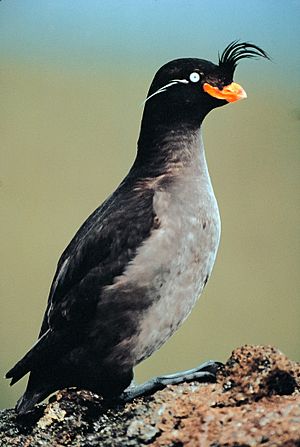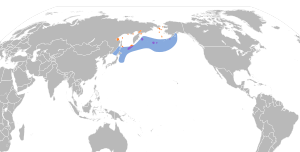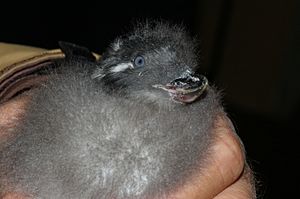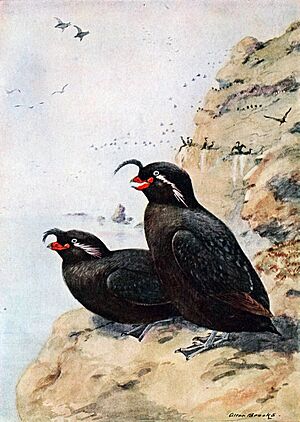Crested auklet facts for kids
Quick facts for kids Crested auklet |
|
|---|---|
 |
|
| Conservation status | |
| Scientific classification | |
| Genus: |
Aethia
|
| Species: |
cristatella
|
 |
|
| Synonyms | |
|
Alca cristatella |
|
The crested auklet (Aethia cristatella) is a small seabird that lives in the northern Pacific Ocean and the Bering Sea. These birds are part of the auk family. They find their food by diving deep underwater. They mainly eat tiny sea creatures like krill.
Crested auklets build their nests in huge groups called colonies. Some colonies can have up to 1 million birds! They often share their nesting areas with a smaller bird called the least auklet.
These birds are special because both males and females have unique features. They have colorful feathers, a cool crest on their head, and a strong smell like citrus fruit. They also make a loud trumpet-like call. Scientists believe these features help them find mates. There are about 6 million crested auklets in the world. Most of them are doing well, but the ones in Alaska face some dangers like oil spills.
Contents
What is a Crested Auklet?
The crested auklet was first described in 1769 by a German scientist named Peter Simon Pallas. Its scientific name, cristatella, means "little crested" in Latin. This refers to the feathers on its head.
The crested auklet belongs to a group of birds called Aethia. This group includes four types of auklets. The crested auklet is most closely related to the whiskered auklet. The larger bird family, Alcidae, includes many other seabirds like puffins, razorbills, and guillemots.
What Does a Crested Auklet Look Like?
Crested auklets are about 18 to 27 centimeters (7 to 11 inches) long. Their wings can spread out 34 to 50 centimeters (13 to 20 inches). They weigh between 195 and 330 grams (7 to 12 ounces).
They have a bright reddish-orange and yellow beak. Their eyes are yellowish-white. They also have white feathers that look like plumes near their ears. Their bodies, wings, and tails are mostly dark gray. Their legs and feet are gray, and their claws are black. Males and females look very similar. Females might have slightly smaller beaks and crests.
The Crest and Other Features
The most famous part of the crested auklet is its forehead crest. This crest is made of black feathers that curve forward. The number of feathers in the crest can be different for each bird, from two to twenty-three. On average, they have about 12 crest feathers. These feathers can be different lengths, from 8 to 58 millimeters (0.3 to 2.3 inches).
Crested auklets also have plumes near their ears and a bright orange beak. These features also vary a lot among different birds. During the breeding season, the crest and a special citrus-like smell help identify them. This smell comes from tiny feathers between their shoulder blades. In winter, their beaks become smaller and duller yellow. Their crests and ear plumes are also smaller.
Young auklets look like adults in winter, but they don't have the crest or ear plumes. Their beaks are smaller and brownish-yellow. It takes about 33 days for young auklets to grow to adult size.
Where Do Crested Auklets Live?
Crested auklets live across the northern Pacific Ocean and the Bering Sea. In winter, when they are not breeding, many can be found near the Aleutian Islands, the Kuril Islands, and the Russian island of Sakhalin.
In late spring and summer, they travel to islands and coastlines in the Sea of Okhotsk and the Bering Sea to breed. They like to live on rocky slopes, lava flows, and sea cliffs. They often share their homes with other types of auklets. When something disturbs them or a predator is near, crested auklets will often fly in circles about 500 meters (1,640 feet) above the sea and their colonies.
How Do Crested Auklets Behave?
What Do Crested Auklets Eat?
Crested auklets usually look for food in deep waters. Sometimes they feed closer to shore, but always in large groups. We don't know much about what they eat in winter. However, it is thought they eat many different small sea animals.
Crested auklets are planktivores, meaning they eat plankton. Their main food is krill. They also eat tiny creatures like copepods, pteropods, amphipods, and young fish. They dive from the water's surface to catch their food. This diving looks a bit like they are "flying" underwater.
How Do Crested Auklets Raise Their Young?
The breeding season for crested auklets starts in mid-May and ends in mid-August. They nest in rocky cracks along the North Pacific coast. They form very large colonies, sometimes with up to one million birds. Because there are so many birds, their nests are very close together, sometimes only 0.3 meters (1 foot) apart.
Even with so many birds, they are very protective of their nesting spots. Most pairs stay together for the whole breeding season. Mating happens at sea. Males do not have a special organ for mating, so they must hover over the females to mate successfully. Both males and females choose their partners, but the female makes the final decision.
Crested auklets are very social during the breeding season. Once they find a mate, they usually stay with that partner for the year. However, only about 45% of birds stay with the same partner the next year. Both parents take turns sitting on the single egg and raising the chick.
How Do Crested Auklets Attract Mates?
Crested auklets have special features that help them attract mates. These are called "ornaments."
Visual Ornaments: The Crest
The length of a bird's crest shows how strong or dominant it is. Both males and females with longer crests get more attention from potential mates. Birds with bigger crests are more likely to find a partner and form a pair bond earlier in the season.
If a pair breaks up or one bird dies, more than half of the birds find a new mate each year. For females, the length of their crest is the main reason why males might switch partners between years.
The crests and other feather ornaments of crested auklets usually look the same on an individual bird over time. They also don't show much difference between males and females. Some scientists think these ornaments might even help the birds in other ways. For example, the long facial feathers might help them feel their way around in the dark, tight spaces where they nest.
Vocal Ornaments: The Trumpet Call
Crested auklets make many different sounds. "Billing" is a special courtship behavior where a pair makes mutual cackling sounds. This is very important for pairs to bond.
The "trumpet call" is one of their most common calls. It's a complex sound that goes with a specific visual display. Each bird's call is unique in how long it lasts and its pitch. Males usually make these calls, but females can too, especially if they have lost their mate. These calls stay the same year after year. They help birds recognize their long-term partners and even their neighbors. Recognizing neighbors helps them avoid fights and save energy.
Olfactory Ornaments: The Citrus Scent
Crested auklets have a unique citrus-like smell from their feathers. This scent is released when they ruffle the feathers on their neck and upper back. This happens when they feel threatened, make trumpet calls, or do billing displays.
When the scent is released, it encourages other birds to do a "ruff sniff" display. This is when a bird puts its beak into another bird's feathers. This display is important for pairs to form. For both males and females, a stronger smell attracts more birds to do the ruff sniff display.
The amount of scent they produce increases during the breeding season. This shows how important it is for courtship and choosing a mate. The scent might also help keep away tiny bugs that live on their bodies. The whiskered auklet also has this special scent.
Are Crested Auklets in Danger?

The International Union for the Conservation of Nature says that crested auklets are of "Least Concern". This means they are not currently in danger of disappearing. There are more than 8.2 million crested auklets worldwide. About 2.9 million of them live in North America. However, it's hard to count them exactly because many birds are hidden in their nests or out at sea.
There is more worry about the crested auklet population in Alaska. Rats that escape from fishing boats can eat their eggs and chicks. Their main natural enemies are gulls, Arctic foxes, and common ravens. They have also been found in the stomachs of halibut fish.
Other dangers include Oil spills, which can cover their feathers and make them sick. They can also crash into bright lights. In Alaska, some people still hunt crested auklets for food.
Images for kids
See also
 In Spanish: Mérgulo empenachado para niños
In Spanish: Mérgulo empenachado para niños








